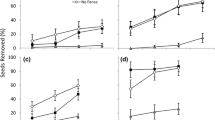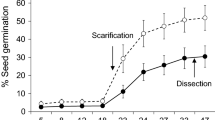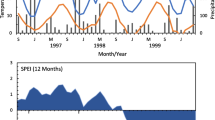Abstract
In all plant populations, establishment is controlled by two factors: the supply of propagules and their access to ‘safe sites’ for growth. An infestation of invading pest plants results in a seed-production gradient, from the edge where seeds are limiting, to the center where seeds may be in excess. Do invaded sites become ‘saturated’ with seeds? How rapidly does this occur, and how does the process depend on the availability of safe sites? Are safe sites, and consequently invasion, promoted by disturbance? I quantified the response of seedling establishment to seed input and disturbance in Cytisus scoparius (Scotch broom), an exotic shrub invading glacial outwash prairie remnants in western Washington, USA. I used disturbance treatments to investigate the role of the thick cryptogamic layer in these prairies, disturbing cryptogams by scraping or by fire. The effect of fire was partitioned into two factors: burning of the background vegetation/substrate versus breaking C. scoparius seed dormancy, by adding seeds either before or after the burn. Seed treatments ranged from 20 to 1000 seeds per m2. Both seed number and surface treatment showed significant effects on seedling density, along with a significant interaction between the two factors. Disturbance did not promote C. scoparius establishment; undisturbed plots produced more seedlings than burned or scraped plots. Within the burned plots, fire scarification appeared to increase germination but this effect was not significant. For germinated seedlings, mortality through the dry season (June–August) was not significantly different among surface treatments, nor did survivorship depend on density, with the result that initial differences in germination among the treatments persisted. The message that the undisturbed cryptogam layer facilitates C. scoparius establishment suggests that ‘ecosystem management’ strategies promoting healthy, undisturbed sites will not always be effective against invasive pest species.
Similar content being viewed by others
References
Andersen AN (1989) How important is seed predation to recruitment in stable populations of long-lived perennials? Oecologia (Berlin) 81: 310-315
Anderson DC,Harper KT andHolmgren RC (1982) Factors influencing development of cryptogamic soil crusts in Utah deserts. Journal of Range Management 35: 180-185
Belnap J (1993) Recovery rates of cryptobiotic crusts: Inoculant use assessment methods. Great Basin Naturalist 53: 89-95
Bliss LC andGold WG (1999) Vascular plant reproduction, establishment, and growth and the effects of cryptogamic crusts within a polar desert ecosystem, Devon Island, N.W.T., Canada. Canadian Journal of Botany 77: 623-636
Bossard CC (1990a) Secrets of an ecological interloper: Ecological studies on Cytisus scoparius in California. PhD Thesis. University of California, Davis
Bossard CC (1990b) Tracing of ant-dispersed seeds: a newtechnique. Ecology (Tempe) 71: 2370-2371
Bossard CC (1991) The role of habitat disturbance, seed predation and ant dispersal on establishment of the exotic shrub Cytisus scoparius in California. American Midland Naturalist 126: 1-13
Bossard CC,Randall JM andHoshovsky MC (eds) (2000) Invasive Plants of California's Wildlands. University of California Press, Berkeley
Chappell CB andCrawford RC (1997) Native vegetation of the south Puget Sound prairie landscape. In: Dunn P andEwing K (eds) Ecology and Conservation of the South Puget Sound Prairie Landscape, pp 107-122. The Nature Conservancy, Seattle, Washington
Crawley MJ (1990) The population dynamics of plants. Philosophical Transactions of the Royal Society of London B Biological Sciences 330: 125-140
Crawley MJ (1992) Seed predators and population dynamics. In: Fenner M (ed) Seeds: The Ecology of Regeneration in Plant Communities, pp 157-191. CAB International, Wallingford, UK
Cross JR (1981) The establishment of Rhododendron ponticum in the Killarny oakwoods, S.W. Ireland. Journal of Ecology 69: 807-824
Downey PO (2000) Broom (Cytisus scoparius (L.) Link) and fire: Management implications. Plant Protection Quarterly 15: 178-183
Downey PO andSmith JMB (2000) Demography of the invasive shrub Scotch broom (Cytisus scoparius) at Barrington Tops, New SouthWales: Insights for management. Austral Ecology 25: 477-485
Dunn P andEwing K (eds) (1997) Ecology and Conservation of the South Puget Sound Prairie Landscape. The Nature Conservancy, Seattle, Washington
Eldridge DJ (1993) Cryptogams, vascular plants, and soil hydrological relations: Some preliminary results from the semiarid woodlands of eastern Australia. Great Basin Naturalist 53: 48-58
Eriksson O andEhrlen J (1992) Seed and Microsite Limitation of Recruitment in Plant Populations. Oecologia (Berlin) 91: 360-364
Ewel JJ (1986) Invasibility: Lessons from south Florida. In: Mooney HA andDrake JA (eds) Ecology of Biological Invasions of North America and Hawaii, pp 214-249. Springer-Verlag, New York
Franklin JF andDyrness CT (1988) Natural vegetation of Oregon and Washington. Oregon State University Press, Corvallis
Gentle CB andDuggin JA (1997) Lantana camara L. invasions in dry rainforest-open forest ecotones: The role of disturbances associated with fire and cattle grazing. Australian Journal of Ecology 22: 298-306
Gilkey HM (1957) Weeds of the Pacific Northwest. Oregon State College, Corvallis
Gold WG (1998) The influence of cryptogamic crusts on the thermal environment and temperature relations of plants in a high arctic polar desert, Devon Island, N.W.T., Canada. Arctic and Alpine Research 30: 108-120
Gold WG,Glew KA andDickson LG (2001) Functional influences of cryptobiotic surface crusts in an alpine tundra basin of the Olympic Mountains, Washington, USA. Northwest Science 75: 315-326
Harper JL (1977) Population Biology of Plants. Academic Press, New York
Harper KT andBelnap J (2001) The influence of biological soil crusts on mineral uptake by associated vascular plants. Journal of Arid Environments 47: 347-357
Harper KT andMarble JR (1988) A role for nonvascular plants in management of arid and semiarid rangelands. In: Tueller PT (ed) Application of Plant Sciences to Rangeland Management and Inventory, pp 135-169. Kluwer Academic Publishers, Boston
Harper KT andPendleton RL (1993) Cyanobacteria and cyanolichens: Can they enhance availability of essential minerals for higher plants? Great Basin Naturalist 53: 59-72
Hartway C andSteinberg EK (1997) The influence of pocket gopher disturbance on the distribution and diversity of plants in western Washington prairies. In: Dunn P andEwing K (eds) Ecology and Conservation of the South Puget Sound Prairie Landscape, pp 131-139. The Nature Conservancy, Seattle, Washington
Hobbs RJ (1989) The nature and effects of disturbance relative to invasions. In: Drake JA,Mooney HA,di Castri F et al. (eds) Biological Invasions: A Global Perspective, pp 389-405. Wiley & Sons, New York
Hobbs RJ andHuenneke LF (1992) Disturbance, diversity, and invasion: Implications for conservation. Conservation Biology 6: 324-337
Hobbs RJ andMooney HA (1985) Community and population dynamics of serpentine grassland annuals in relation to gopher disturbance. Oecologia (Berlin) 67: 342-351
Hoffmann JH andMoran VC (1991) Biological Control of Sesbania-Punicea Fabaceae in South Africa. Agriculture Ecosystems and Environment 37: 157-174
Hoshovsky M (1986) Element Stewardship Abstract for Cytisus scoparius and Cytisus monspessulanus, Scotch broom and French broom. The Nature Conservancy, Arlington, Virginia
Isaacson DL (2000) Impacts of broom (Cytisus scoparius) in western North America. Plant Protection Quarterly 15: 145-148
Jesson L,Kelly D andSparrow A (2000) The importance of dispersal, disturbance, and competition for exotic plant invasions in Arthur's Pass National Park, NewZealand. NewZealand Journal of Botany 38: 451-468
Johansen JR,St Clair LL,Webb BL andNebeker GT (1984) Recovery patterns of cryptogamic soil crusts in desert rangelands following fire disturbance. Bryologist 87: 238-243
Johansen JR,Ashley J andRayburn WR (1993) Effects of range-fire on soil algal crusts in semiarid shrub-steppe of the Lower Columbia Basin and their subsequent recovery. Great Basin Naturalist 53: 73-88
King SE andGrace JB (2000) The effects of gap size and disturbance type on invasion of wet pine savanna by cogongrass, Imperata cylindrica (Poaceae). American Journal of Botany 87: 1279-1286
Kotanen PM (1995) Responses of vegetation to a changing regime of disturbance: Effects of feral pigs in a Californian coastal prairie. Ecography 18: 190-198
Kruckeberg AR (1991) The Natural History of Puget Sound Country. University of Washington Press, Seattle, Washington
Lewontin RC (1965) Selection for colonizing ability. In: Baker HG andStebbins GL (eds) The Genetics of Colonizing Species, pp 79-94. Academic Press, New York
Louda SM (1982) Distribution ecology: Variation in plant recruitment over a gradient in relation to insect seed predation. Ecological Monographs 52: 25-41
Louda SM andPotvin MA (1995) Effect of inflorescence-feeding insects on the demography and lifetime fitness of a native plant. Ecology (Washington DC) 76: 229-245
Louda SM,Potvin MA andCollinge SK (1990) Predispersal seed predation, postdispersal seed predation and competition in the recruitment of seedlings of a native thistle in Sandhills prairie (Nebraska, USA). American Midland Naturalist 124: 105-113
Maron JL andGardner SN (2000) Consumer pressure, seed versus safe-site limitation, and plant population dynamics. Oecologia (Berlin) 124: 260-269
McClintock E (1985) Status reports on invasive weeds: Brooms. Fremontia 12: 17-18
Metting B (1991) Biological surface features of semiarid lands and deserts. In: Skujins J (ed) Semiarid Lands and Deserts: Soil Resource and Reclamation, pp 257-293. Marcel Dekker, New York
Mobley L (1954) Scotch broom, a menace to forest, range, and agricultural land. Proceedings of the 6th Annual California Weed Conference, pp 39-42
Orians GH (1986) Site characteristics favoring invasions. In: Mooney HA andDrake JA (eds) Ecology of Biological Invasions of North America and Hawaii, pp 133-148. Springer-Verlag, New York
Parendes LA andJones JA (2000) Role of light availability and dispersal in exotic plant invasion along roads and streams in the H.J. Andrews Experimental Forest, Oregon. Conservation Biology 14: 64-75
Parker IM (1996) Ecological factors affecting rates of population growth and spread in Cytisus scoparius, an invasive exotic shrub. PhD Thesis. University of Washington
Parker IM (2000) Invasion dynamics of Cytisus scoparius: A matrix model approach. Ecological Applications 10: 726-743
Parker IM,Mertens SK andSchemske DW (1993) Distribution of seven native and two exotic plants in a tallgrass prairie in southeastern Wisconsin: The importance of human disturbance. The American Midland Naturalist 130: 43-55
Paynter Q,Fowler SV,Memmott J,Shaw RH andSheppard AW (2000) Determinants of broom (Cytisus scoparius (L.) Link) abundance in Europe. Plant Protection Quarterly 15: 149-155
Paynter Q,Fowler SV,Memmott J andSheppard AW (1998) Factors affecting the establishment of Cytisus scoparius in southern France: Implications for managing both native and exotic populations. Journal of Applied Ecology 35: 582-595
Rees M andPaynter Q (1997) Biological control of Scotch broom: Modelling the determinants of abundance and the potential impact of introduced insect herbivores. Journal of Applied Ecology 34: 1203-1221
Reifner RE andBowler PA (1995) Cushion-like fruticose lichens as Dudleya seed traps and nurseries in coastal communities. Madroño 42: 81-82
Sheppard A,Hodge P andPaynter Q (2000) Factors affecting broom regeneration in Australia and their management implications. Plant Protection Quarterly 15: 156-161
Snedecor GW andCochran WG (1989) Statistical Methods. Iowa State University Press, Aimes
St Clair LL,Webb BL,Johansen JR andBebeker GT (1984) Cryptogamic soil crusts: Enhancement of seedling establishment in disturbed and undisturbed areas. Reclamation and Revegetation Research 3: 129-136
Tveten R (1997) Fire effects on prairie vegetation, Fort Lewis, Washington. In: Dunn P andEwing K (eds) Ecology and Conservation of the South Puget Sound Prairie Landscape, pp 123-130. The Nature Conservancy, Seattle, Washington
Tveten RK andFonda RW (1999) Fire effects on prairies and oak woodlands on Fort Lewis, Washington. Northwest Science 73: 145-158
US Army Corps of Engineers (1994) Final Environmental Impact Statement: Stationing of Mechanized or Armored Combat Forces at Fort Lewis, Washington. Fort Lewis, Washington, US Department of the Army
Watts SE (1998) Short-term influence of tank tracks on vegetation and microphytic crusts in shrubsteppe habitat. Environmental Management 22: 611-616
Youngman BJ (1951) Germination of old seeds. Kew Bulletin 23: 423-426
Author information
Authors and Affiliations
Rights and permissions
About this article
Cite this article
Parker, I.M. Safe Site and Seed Limitation in Cytisus Scoparius (Scotch Broom): Invasibility, Disturbance, and the Role of Cryptogams in a Glacial Outwash Prairie. Biological Invasions 3, 323–332 (2001). https://doi.org/10.1023/A:1015855515361
Issue Date:
DOI: https://doi.org/10.1023/A:1015855515361




